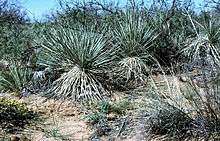Yucca campestris
| Yucca campestris | |
|---|---|
 | |
| Scientific classification | |
| Kingdom: | Plantae |
| Clade: | Angiosperms |
| Clade: | Monocots |
| Order: | Asparagales |
| Family: | Asparagaceae |
| Subfamily: | Agavoideae |
| Genus: | Yucca |
| Species: | Y. campestris |
| Binomial name | |
| Yucca campestris McKelvey | |
Yucca campestris, the plains yucca,[1] is a species in the family Asparagaceae, endemic to the "panhandle" region of northwestern Texas.[2][1]
Yucca campestris is a low-growing species spreading by underground rhizomes and producing large colonies of rosettes. Leaves are long and narrow, up to 65 cm long but rarely more than 15 mm wide. Flowers are white and drooping. Fruit is a dry capsule with glossy black seeds.[1]
Yucca campestris grows in deep sands in very dry regions. It can be grown as an ornamental in desert regions, preferring warm climates and full sunlight. The plant has blue-green leaves and panicles of showy white flowers.[3]
References
- 1 2 3 Flora of North America
- ↑ McKelvey, Susan D. Yuccas of the southwestern United States, (1947): 173 ff., The Arnold Arboretum of Harvard University, Jamaica Plain, Massachusetts, USA. 1947
- ↑ Texas A&M University, Texas Native Plants Database, Plains Yucca
This article is issued from Wikipedia - version of the 8/9/2015. The text is available under the Creative Commons Attribution/Share Alike but additional terms may apply for the media files.